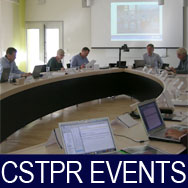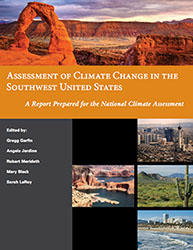Announcements
New Book Release: CSTPR Researchers Contribute to Analysis of Southwest’s Climate Future
May 9, 2013
In an era of increasing climate instability, the southwestern United States faces strained water resources, greater prevalence of tree-killing pests, and potentially significant alterations of agricultural infrastructure. These threats and challenges as well as others are detailed in the new book, “Assessment of Climate Change in the Southwest United States.”
A hotter future is projected for the Southwestern United States—a region stretching from the California coast to the plains of eastern Colorado and New Mexico—and future heat and changes in precipitation will present challenges for managing natural resources, water, infrastructure and threats to human health.
The new book, “Assessment of Climate Change in the Southwest United States,” published by Island Press, is a landmark study that addresses these issues. It focuses on current climate conditions in the region, the environment of the past, what is projected to change over the 21st century and how this will impact ecosystems, water resources, agricultural production, energy supply and delivery, transportation and human health. The work includes major contributions from fourteen University of Colorado scientists, twelve of whom are part of CIRES and three from CSTPR.
A consortium of researchers from the Southwest Climate Alliance coordinated the assessment and the scientists are affiliated with the National Oceanic and Atmospheric Administration’s Regional Integrated Sciences and Assessment Program and the U.S. Department of the Interior Southwest Climate Science Center. The book blends the contributions of 120 experts in climate science, economics, ecology, engineering, geography, hydrology, planning, resource management and other disciplines. The book is one of ten regional technical inputs to the 2013 National Climate Assessment released in draft form earlier this year.
"It's exciting to be part of an effort that really brought together the best possible science on climate change in the Southwest," said CIRES Associate Director for Science Kristen Averyt, who is a lead author of a chapter of the book. "We now have a clearer, fuller picture of how warmer temperatures are leading to earlier snowmelt, greater evaporation, more wildfires, and other very serious impacts affecting pretty much every square inch of our region."
Besides Averyt, Brad Udall, who is now director of the Getches-Wilkinson Center for Natural Resources, Energy and Environment, is also a lead author of a book chapter. Other CIRES scientists who contributed to chapters are Joe Barsugli, Maxwell Boykoff, Lisa Dilling, Jon Eischeid, Eric Gordon, Brant Liebmann, Jeff Lukas, Balaji Rajagopalan, Imtiaz Rangwala, William Travis, and Klaus
Wolter. The work of Ami Nacu-Schmidt is also integral to the book, as she created or adapted the majority of the graphics illustrating the authors' findings.
The new book stresses the choices and opportunities available to society, in order to reduce the causes and effects of climate change in the region. It notes the steps governments, businesses, organizations and individuals are taking to improve energy efficiency, improve water supply reliability, decrease wildfire risk, and reduce greenhouse gas emissions.
“Assessment of Climate Change in the Southwest United States” is available from www.islandpress.org and at major retailers. The Assessment website http://www.swcarr.arizona.edu provides access to download full book chapters, short summaries of each chapter, and all graphics developed for the book.



